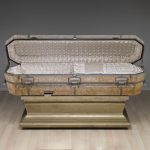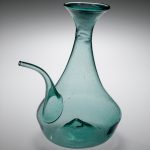It’s not unusual for a piece of art to be controversial. Historically, some of the greatest artworks of all time have been. What makes Olafur Eliasson’s piece space resonates regardless of our presence (Wednesday) so unique, isn’t that it’s inherently controversial, but that to fully understand it means discovering one of the most controversial moments in scientific history.

space resonates regardless of our presence (Wednesday),
Olafur Eliasson, 2017. © Olafur Eliasson. 2017.3.16.
Now on display at The Corning Museum of Glass, (Wednesday) is modest in construction and comprised of just four parts – an LED light, a thin opaque disk, a prismatic glass ring, and the wall-mounted arm that connects them all. The light from the LED is blocked by the disk, and the lens magnifies the ensuing battle between light and dark onto the wall. Despite this simplicity, (Wednesday) elicits an unexpected experience in the viewer. At once awed by the beautiful, concentric rings of shadow that appear on the wall, it’s also possible to be confused by the very things that excite and stir the senses.
Hidden in the simplicity is a mystery that reveals much more than meets the eye. Read more →








